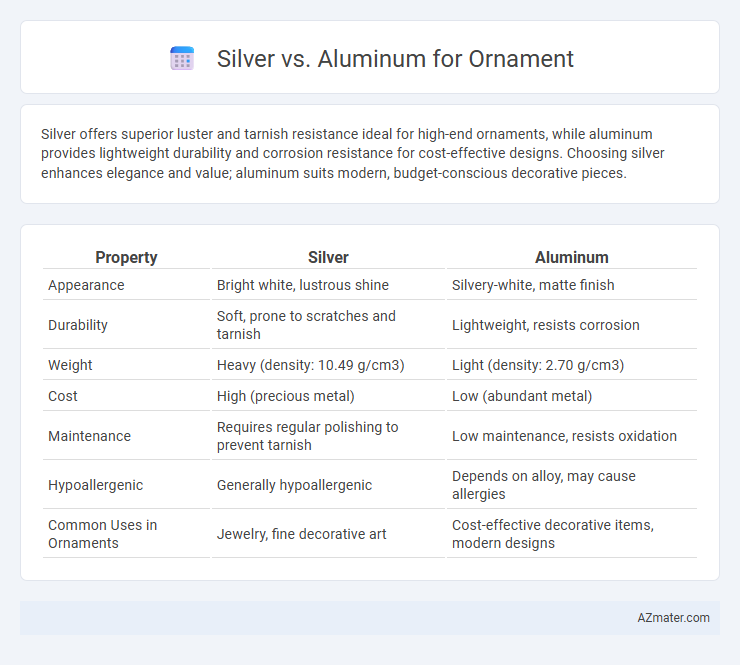Silver offers superior luster and tarnish resistance ideal for high-end ornaments, while aluminum provides lightweight durability and corrosion resistance for cost-effective designs. Choosing silver enhances elegance and value; aluminum suits modern, budget-conscious decorative pieces.
Table of Comparison
| Property | Silver | Aluminum |
|---|---|---|
| Appearance | Bright white, lustrous shine | Silvery-white, matte finish |
| Durability | Soft, prone to scratches and tarnish | Lightweight, resists corrosion |
| Weight | Heavy (density: 10.49 g/cm3) | Light (density: 2.70 g/cm3) |
| Cost | High (precious metal) | Low (abundant metal) |
| Maintenance | Requires regular polishing to prevent tarnish | Low maintenance, resists oxidation |
| Hypoallergenic | Generally hypoallergenic | Depends on alloy, may cause allergies |
| Common Uses in Ornaments | Jewelry, fine decorative art | Cost-effective decorative items, modern designs |
Introduction: Silver vs Aluminum for Ornament Making
Silver offers a timeless, lustrous finish prized for its durability and natural resistance to tarnish in ornament making. Aluminum stands out with its lightweight properties and corrosion resistance, making it a practical choice for large or intricate designs. Both metals provide unique aesthetic and functional benefits, influencing craftsmanship and cost efficiency in jewelry and decorative pieces.
Physical Properties: Silver and Aluminum Compared
Silver exhibits higher density and superior malleability compared to aluminum, making it ideal for intricate ornamental designs. Aluminum's lightweight nature and excellent corrosion resistance provide durability without adding significant weight to ornaments. Thermal and electrical conductivity are significantly greater in silver, enhancing its luster and responsiveness in decorative applications.
Aesthetic Appeal: Shine, Color, and Finish
Silver offers a brilliant, reflective shine that enhances its luxurious and timeless aesthetic, making it a preferred choice for high-end ornaments. Its naturally bright white color maintains its luster over time, providing a classic finish that complements intricate designs and detailed craftsmanship. Aluminum, while lightweight and resistant to tarnish, presents a duller, matte finish with a cooler, grayish tone, making it less vibrant but suitable for modern, minimalist ornament styles.
Durability and Longevity of Ornaments
Silver ornaments offer superior durability due to their resistance to tarnishing and corrosion, ensuring long-lasting shine and structural integrity. Aluminum, while lightweight and corrosion-resistant, tends to be softer and more prone to dents or scratches over time. For ornaments intended as heirlooms or long-term decorations, silver's robust composition provides enhanced longevity and enduring aesthetic appeal.
Weight Differences: Handling and Display Considerations
Silver ornaments typically weigh more than aluminum ones due to silver's higher density of 10.49 g/cm3 compared to aluminum's 2.70 g/cm3, impacting handling ease and display stability. Heavier silver pieces offer a luxurious feel but may require sturdier supports to prevent damage or tipping. Aluminum's lightweight nature allows for larger, more intricate designs that are easier to hang and less likely to strain display fixtures.
Cost Analysis: Silver vs Aluminum Ornaments
Silver ornaments typically cost significantly more than aluminum due to silver's higher market value and intrinsic metal properties. Aluminum ornaments offer a budget-friendly alternative, with prices often 70-90% lower, making them ideal for large-scale or cost-conscious purchases. Cost efficiency of aluminum is enhanced by its lightweight nature, reducing shipping and handling expenses compared to heavier silver pieces.
Tarnishing and Maintenance Requirements
Silver ornaments develop tarnish over time due to a chemical reaction with sulfur-containing substances in the air, requiring regular polishing to maintain their shine. Aluminum ornaments resist tarnishing as they form a protective oxide layer naturally, which minimizes maintenance needs. Silver demands more frequent care compared to aluminum, making aluminum a convenient choice for low-maintenance decorative items.
Hypoallergenic Qualities for Sensitive Users
Silver is often preferred over aluminum for ornaments due to its superior hypoallergenic qualities, reducing the risk of skin irritation for sensitive users. Aluminum may cause allergic reactions or skin discoloration in individuals with metal sensitivities because it can oxidize and react with sweat. Silver's natural resistance to tarnish and corrosion makes it a safer and more comfortable choice for those prone to allergic skin responses.
Customization and Craftsmanship Flexibility
Silver offers superior customization and craftsmanship flexibility for ornaments due to its malleability and ability to hold intricate details, making it ideal for detailed engraving and delicate designs. Aluminum, while lightweight and corrosion-resistant, is less adaptable to fine embellishments and requires specialized techniques to achieve complex textures. Artisans favor silver when precision and ornate personalization are priorities in ornament creation.
Environmental Impact and Sustainability
Silver mining generates significant environmental pollution due to the use of toxic chemicals like cyanide and mercury, causing soil and water contamination. Aluminum, while energy-intensive to produce from ore, is highly recyclable with up to 95% of the original energy saved during recycling, making it a more sustainable choice for ornaments. Choosing recycled aluminum over newly mined silver reduces carbon footprint and conserves natural resources, promoting long-term environmental sustainability.

Infographic: Silver vs Aluminum for Ornament
 azmater.com
azmater.com